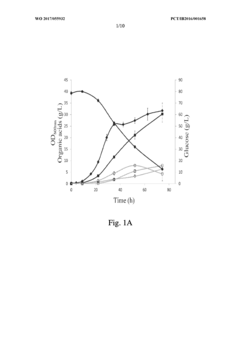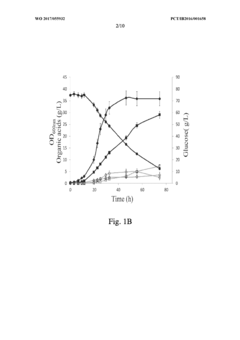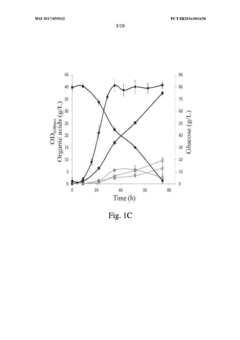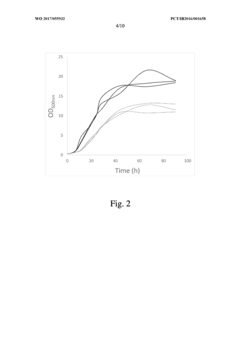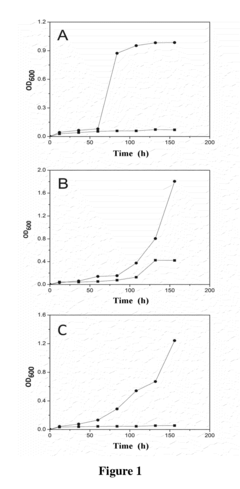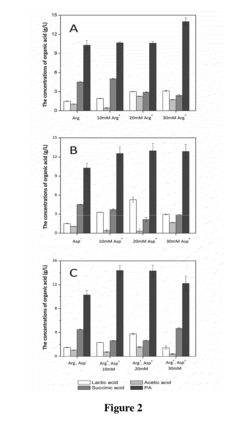Future Outlook on Propionic Acid in Sustainable Development
JUL 3, 20259 MIN READ
Generate Your Research Report Instantly with AI Agent
Patsnap Eureka helps you evaluate technical feasibility & market potential.
Propionic Acid Evolution and Sustainability Goals
Propionic acid has undergone significant evolution in its production methods and applications, aligning with global sustainability goals. Initially produced through petrochemical processes, the industry has shifted towards more sustainable bio-based production methods. This transition reflects the growing emphasis on reducing carbon footprints and embracing circular economy principles in chemical manufacturing.
The evolution of propionic acid production has been marked by key milestones. In the mid-20th century, petrochemical routes dominated, utilizing propanol oxidation or ethylene carbonylation. However, the 1990s saw increased interest in bio-based alternatives, with fermentation processes using renewable feedstocks gaining traction. This shift was driven by environmental concerns and the need for sustainable chemical production.
Recent years have witnessed remarkable advancements in biotechnology, enabling more efficient microbial production of propionic acid. Genetic engineering of microorganisms, particularly Propionibacterium species, has led to improved yields and productivity. These developments have made bio-based propionic acid increasingly competitive with its petrochemical counterpart, both in terms of cost and environmental impact.
The sustainability goals associated with propionic acid align closely with the United Nations Sustainable Development Goals (SDGs), particularly SDG 12 (Responsible Consumption and Production) and SDG 13 (Climate Action). The industry aims to reduce greenhouse gas emissions, minimize waste, and optimize resource utilization throughout the production lifecycle. This includes exploring renewable feedstocks, improving energy efficiency in manufacturing processes, and developing closed-loop systems for byproduct utilization.
Looking ahead, the propionic acid industry is set to play a crucial role in the transition towards a more sustainable chemical sector. Research efforts are focused on further enhancing bio-based production methods, exploring novel feedstocks such as agricultural waste and algal biomass, and developing more efficient purification techniques. Additionally, there is growing interest in integrating propionic acid production with other biorefinery processes to maximize resource efficiency and economic viability.
The evolution of propionic acid also extends to its applications. While traditionally used as a preservative and intermediate in various industries, new sustainable applications are emerging. These include its use in biodegradable plastics, environmentally friendly de-icing solutions, and as a building block for bio-based materials. Such innovations not only expand the market for propionic acid but also contribute to the broader goals of sustainability and circular economy.
The evolution of propionic acid production has been marked by key milestones. In the mid-20th century, petrochemical routes dominated, utilizing propanol oxidation or ethylene carbonylation. However, the 1990s saw increased interest in bio-based alternatives, with fermentation processes using renewable feedstocks gaining traction. This shift was driven by environmental concerns and the need for sustainable chemical production.
Recent years have witnessed remarkable advancements in biotechnology, enabling more efficient microbial production of propionic acid. Genetic engineering of microorganisms, particularly Propionibacterium species, has led to improved yields and productivity. These developments have made bio-based propionic acid increasingly competitive with its petrochemical counterpart, both in terms of cost and environmental impact.
The sustainability goals associated with propionic acid align closely with the United Nations Sustainable Development Goals (SDGs), particularly SDG 12 (Responsible Consumption and Production) and SDG 13 (Climate Action). The industry aims to reduce greenhouse gas emissions, minimize waste, and optimize resource utilization throughout the production lifecycle. This includes exploring renewable feedstocks, improving energy efficiency in manufacturing processes, and developing closed-loop systems for byproduct utilization.
Looking ahead, the propionic acid industry is set to play a crucial role in the transition towards a more sustainable chemical sector. Research efforts are focused on further enhancing bio-based production methods, exploring novel feedstocks such as agricultural waste and algal biomass, and developing more efficient purification techniques. Additionally, there is growing interest in integrating propionic acid production with other biorefinery processes to maximize resource efficiency and economic viability.
The evolution of propionic acid also extends to its applications. While traditionally used as a preservative and intermediate in various industries, new sustainable applications are emerging. These include its use in biodegradable plastics, environmentally friendly de-icing solutions, and as a building block for bio-based materials. Such innovations not only expand the market for propionic acid but also contribute to the broader goals of sustainability and circular economy.
Market Demand Analysis for Sustainable Propionic Acid
The market demand for sustainable propionic acid is experiencing significant growth, driven by increasing environmental concerns and the shift towards eco-friendly production methods. This organic compound, traditionally derived from petrochemical sources, is now being sought after in its bio-based form, aligning with global sustainability goals.
The food and beverage industry remains the largest consumer of propionic acid, particularly in its role as a natural preservative. With the rising consumer preference for clean label products and natural ingredients, the demand for bio-based propionic acid in food preservation is expected to surge. This trend is further amplified by stringent regulations on synthetic preservatives in many countries, pushing manufacturers to seek sustainable alternatives.
In the animal feed sector, propionic acid's antimicrobial properties make it a valuable additive for preventing mold growth in livestock feed. As the global meat consumption continues to rise, especially in developing economies, the demand for high-quality animal feed additives is projected to increase. Sustainable propionic acid fits well into this growing market segment, offering both efficacy and environmental benefits.
The pharmaceutical industry presents another significant market for sustainable propionic acid. Its use in the production of cellulose acetate propionate, a key ingredient in pharmaceutical coatings, is gaining traction. The industry's move towards green chemistry and sustainable manufacturing processes is likely to boost the demand for bio-based propionic acid in this sector.
Emerging applications in biodegradable plastics and eco-friendly solvents are opening new avenues for sustainable propionic acid. As governments worldwide implement stricter environmental regulations and promote circular economy initiatives, industries are actively seeking bio-based alternatives to conventional chemicals. This shift is expected to create substantial market opportunities for sustainable propionic acid in the coming years.
Geographically, North America and Europe are currently the leading markets for sustainable propionic acid, owing to their stringent environmental regulations and high consumer awareness. However, the Asia-Pacific region is anticipated to witness the fastest growth, driven by rapid industrialization, increasing food safety concerns, and growing adoption of sustainable practices in emerging economies like China and India.
The market dynamics are further influenced by the volatility in crude oil prices, which affects the competitiveness of bio-based propionic acid against its petrochemical counterpart. As production technologies for sustainable propionic acid continue to improve, leading to cost reductions, its market penetration is expected to accelerate across various industries.
The food and beverage industry remains the largest consumer of propionic acid, particularly in its role as a natural preservative. With the rising consumer preference for clean label products and natural ingredients, the demand for bio-based propionic acid in food preservation is expected to surge. This trend is further amplified by stringent regulations on synthetic preservatives in many countries, pushing manufacturers to seek sustainable alternatives.
In the animal feed sector, propionic acid's antimicrobial properties make it a valuable additive for preventing mold growth in livestock feed. As the global meat consumption continues to rise, especially in developing economies, the demand for high-quality animal feed additives is projected to increase. Sustainable propionic acid fits well into this growing market segment, offering both efficacy and environmental benefits.
The pharmaceutical industry presents another significant market for sustainable propionic acid. Its use in the production of cellulose acetate propionate, a key ingredient in pharmaceutical coatings, is gaining traction. The industry's move towards green chemistry and sustainable manufacturing processes is likely to boost the demand for bio-based propionic acid in this sector.
Emerging applications in biodegradable plastics and eco-friendly solvents are opening new avenues for sustainable propionic acid. As governments worldwide implement stricter environmental regulations and promote circular economy initiatives, industries are actively seeking bio-based alternatives to conventional chemicals. This shift is expected to create substantial market opportunities for sustainable propionic acid in the coming years.
Geographically, North America and Europe are currently the leading markets for sustainable propionic acid, owing to their stringent environmental regulations and high consumer awareness. However, the Asia-Pacific region is anticipated to witness the fastest growth, driven by rapid industrialization, increasing food safety concerns, and growing adoption of sustainable practices in emerging economies like China and India.
The market dynamics are further influenced by the volatility in crude oil prices, which affects the competitiveness of bio-based propionic acid against its petrochemical counterpart. As production technologies for sustainable propionic acid continue to improve, leading to cost reductions, its market penetration is expected to accelerate across various industries.
Current State and Challenges in Propionic Acid Production
Propionic acid production has seen significant advancements in recent years, yet it still faces several challenges in terms of sustainability and efficiency. Currently, the majority of propionic acid is produced through petrochemical routes, primarily using the oxo process or direct oxidation of propanol. While these methods are well-established, they rely heavily on fossil fuel feedstocks, raising concerns about long-term sustainability and environmental impact.
The biotechnological production of propionic acid has emerged as a promising alternative, offering a more sustainable approach. Fermentation processes using propionibacteria have shown potential for producing propionic acid from renewable resources such as glucose, lactose, and glycerol. However, these biological processes still struggle with low yields, productivity, and high production costs compared to conventional petrochemical methods.
One of the main challenges in propionic acid production is the need for more efficient and cost-effective separation and purification techniques. The recovery of propionic acid from fermentation broths often requires energy-intensive processes, which can significantly impact the overall economics and environmental footprint of production. Developing advanced separation technologies, such as membrane-based processes or novel extractants, is crucial for improving the viability of bio-based production routes.
Another significant challenge lies in strain development and metabolic engineering of microorganisms for enhanced propionic acid production. While progress has been made in improving yields and productivity, there is still a considerable gap between laboratory-scale results and industrial requirements. Researchers are focusing on developing robust strains capable of tolerating higher acid concentrations and utilizing a broader range of substrates, including lignocellulosic biomass and industrial waste streams.
The integration of propionic acid production with other biorefinery processes presents both opportunities and challenges. Co-production strategies, where propionic acid is produced alongside other valuable chemicals or biofuels, could improve overall process economics. However, optimizing these integrated systems requires careful consideration of process design, energy efficiency, and product separation.
Regulatory and market challenges also play a significant role in the current state of propionic acid production. The transition from petrochemical to bio-based production routes requires supportive policies and market incentives to overcome the initial cost barriers. Additionally, ensuring consistent quality and supply of bio-based propionic acid to meet industry standards remains a critical challenge for widespread adoption.
As the demand for sustainable chemicals continues to grow, addressing these challenges in propionic acid production becomes increasingly important. Collaborative efforts between academia, industry, and policymakers are essential to drive innovation and overcome the technical and economic hurdles facing sustainable propionic acid production.
The biotechnological production of propionic acid has emerged as a promising alternative, offering a more sustainable approach. Fermentation processes using propionibacteria have shown potential for producing propionic acid from renewable resources such as glucose, lactose, and glycerol. However, these biological processes still struggle with low yields, productivity, and high production costs compared to conventional petrochemical methods.
One of the main challenges in propionic acid production is the need for more efficient and cost-effective separation and purification techniques. The recovery of propionic acid from fermentation broths often requires energy-intensive processes, which can significantly impact the overall economics and environmental footprint of production. Developing advanced separation technologies, such as membrane-based processes or novel extractants, is crucial for improving the viability of bio-based production routes.
Another significant challenge lies in strain development and metabolic engineering of microorganisms for enhanced propionic acid production. While progress has been made in improving yields and productivity, there is still a considerable gap between laboratory-scale results and industrial requirements. Researchers are focusing on developing robust strains capable of tolerating higher acid concentrations and utilizing a broader range of substrates, including lignocellulosic biomass and industrial waste streams.
The integration of propionic acid production with other biorefinery processes presents both opportunities and challenges. Co-production strategies, where propionic acid is produced alongside other valuable chemicals or biofuels, could improve overall process economics. However, optimizing these integrated systems requires careful consideration of process design, energy efficiency, and product separation.
Regulatory and market challenges also play a significant role in the current state of propionic acid production. The transition from petrochemical to bio-based production routes requires supportive policies and market incentives to overcome the initial cost barriers. Additionally, ensuring consistent quality and supply of bio-based propionic acid to meet industry standards remains a critical challenge for widespread adoption.
As the demand for sustainable chemicals continues to grow, addressing these challenges in propionic acid production becomes increasingly important. Collaborative efforts between academia, industry, and policymakers are essential to drive innovation and overcome the technical and economic hurdles facing sustainable propionic acid production.
Existing Sustainable Production Methods for Propionic Acid
01 Production methods of propionic acid
Various methods for producing propionic acid are described, including fermentation processes, chemical synthesis routes, and catalytic reactions. These methods aim to improve yield, efficiency, and purity of propionic acid production for industrial applications.- Production methods of propionic acid: Various methods are employed for the production of propionic acid, including fermentation processes, chemical synthesis, and catalytic reactions. These methods aim to improve yield, efficiency, and purity of the final product. Some approaches involve the use of specific microorganisms or catalysts to facilitate the conversion of raw materials into propionic acid.
- Applications of propionic acid in food preservation: Propionic acid is widely used as a food preservative due to its antimicrobial properties. It is effective in inhibiting the growth of mold and certain bacteria, thereby extending the shelf life of various food products. The acid and its salts are commonly added to baked goods, dairy products, and animal feed to prevent spoilage and maintain quality.
- Propionic acid derivatives and their uses: Derivatives of propionic acid, such as esters and salts, have diverse applications in industries including pharmaceuticals, cosmetics, and agriculture. These compounds often exhibit enhanced properties or specific functionalities compared to the parent acid. Research focuses on developing novel derivatives with improved efficacy or reduced side effects for various applications.
- Environmental and safety considerations in propionic acid handling: The production, storage, and use of propionic acid require careful consideration of environmental and safety factors. This includes developing methods for safe handling, implementing proper containment measures, and addressing potential environmental impacts. Research in this area focuses on minimizing risks associated with propionic acid and its derivatives throughout their lifecycle.
- Analytical methods for propionic acid detection and quantification: Various analytical techniques are employed for the detection and quantification of propionic acid in different matrices. These methods are crucial for quality control in production processes, monitoring food preservation efficacy, and ensuring compliance with regulatory standards. Advances in analytical technologies aim to improve the accuracy, sensitivity, and speed of propionic acid analysis.
02 Applications of propionic acid in food preservation
Propionic acid and its salts are widely used as food preservatives due to their antimicrobial properties. They are effective in preventing mold growth and extending the shelf life of various food products, particularly in baked goods and dairy products.Expand Specific Solutions03 Use of propionic acid in pharmaceutical formulations
Propionic acid and its derivatives are utilized in pharmaceutical formulations for various purposes, including as excipients, pH adjusters, and active ingredients in certain medications. They play a role in improving drug stability, solubility, and bioavailability.Expand Specific Solutions04 Industrial applications of propionic acid
Propionic acid finds diverse industrial applications beyond food and pharmaceuticals. It is used in the production of plastics, herbicides, and as a chemical intermediate in the synthesis of various compounds. Its properties make it valuable in industries such as agriculture, textiles, and polymers.Expand Specific Solutions05 Environmental and safety considerations in propionic acid handling
The handling, storage, and disposal of propionic acid require specific safety measures due to its corrosive nature and potential environmental impact. Innovations in this area focus on developing safer handling methods, reducing environmental risks, and improving workplace safety in industries using propionic acid.Expand Specific Solutions
Key Players in Sustainable Propionic Acid Industry
The future outlook for propionic acid in sustainable development presents a competitive landscape characterized by a mix of established players and emerging innovators. The industry is in a growth phase, driven by increasing demand for eco-friendly preservatives and sustainable chemical alternatives. The global market size for propionic acid is expanding, with projections indicating significant growth potential in the coming years. Technologically, the field is advancing rapidly, with companies like BASF, Dow Chemical, and Eastman Chemical leading in innovation. Emerging players such as Kemin Industries and PetroChina are also making strides in developing sustainable production methods. The technology's maturity varies, with traditional petrochemical-based production being well-established, while bio-based and green chemistry approaches are still evolving, offering opportunities for differentiation and market disruption.
China Petroleum & Chemical Corp.
Technical Solution: China Petroleum & Chemical Corp. (Sinopec) is advancing sustainable propionic acid production through innovative catalytic processes. They have developed a novel heterogeneous catalyst system for the direct oxidation of propane to propionic acid, achieving improved selectivity and yield[3]. This approach reduces energy consumption and waste generation compared to traditional methods. Sinopec is also investigating the integration of renewable hydrogen in their propionic acid synthesis, aiming to further reduce the carbon footprint of production[4]. Additionally, they are exploring the use of biomass-derived feedstocks in conjunction with their catalytic processes to create a more sustainable production pathway.
Strengths: Extensive petrochemical expertise, large-scale production capabilities, and strong domestic market presence. Weaknesses: Relatively new to bio-based production methods and potentially slower transition from fossil-based feedstocks.
BASF Corp.
Technical Solution: BASF has developed a sustainable production process for propionic acid using renewable resources. Their approach involves fermenting biomass-derived sugars using proprietary microorganisms. The process achieves high yields and selectivity, reducing carbon footprint by up to 50% compared to traditional petrochemical routes[1]. BASF has also invested in expanding their propionic acid production capacity, with a focus on bio-based feedstocks. They are exploring catalytic oxidation of bio-propanol as an alternative green synthesis route, potentially offering further sustainability improvements[2].
Strengths: Industry-leading biotechnology expertise, established production infrastructure, and strong R&D capabilities. Weaknesses: High initial investment costs for bio-based production and potential feedstock supply chain challenges.
Innovative Technologies in Sustainable Propionic Acid Synthesis
Improved propionibacterium strains for the production of propionic acid
PatentWO2017055932A2
Innovation
- Genome shuffling between selected Propionibacterium strains, such as P. acidipropionici ATCC 4875 and P. acidipropionici ATCC 55737, to generate novel strains with enhanced growth rates and propionic acid production, utilizing genetic material exchange to create strains with improved metabolic pathways and regulatory mechanisms.
Method for Improving Acid tolerance of Propionibacterium acdipropionici
PatentInactiveUS20140178952A1
Innovation
- Adding arginine and/or aspartic acid to the culture medium during the cultivation of Propionibacterium acdipropionici to enhance acid tolerance and propionic acid productivity.
Environmental Impact Assessment of Propionic Acid Production
The environmental impact assessment of propionic acid production is crucial for understanding its role in sustainable development. The production process primarily involves the oxidation of propionaldehyde or the fermentation of sugar or ethanol. Both methods have distinct environmental implications that need careful consideration.
The oxidation method, while efficient, relies on petrochemical feedstocks and generates significant carbon emissions. This process requires high energy inputs and often involves the use of metal catalysts, which can lead to potential environmental contamination if not properly managed. The release of volatile organic compounds (VOCs) during production is another concern, as these can contribute to air pollution and smog formation.
In contrast, the fermentation method offers a more environmentally friendly approach. It utilizes renewable resources such as corn, sugar beets, or glycerol as feedstock, aligning with circular economy principles. This bio-based production route significantly reduces the carbon footprint compared to the petrochemical pathway. However, it is not without challenges. The fermentation process requires large amounts of water and can generate wastewater that needs proper treatment before discharge.
Land use change is another factor to consider, especially if there's an increased demand for agricultural feedstocks for propionic acid production. This could potentially lead to deforestation or competition with food crops, impacting biodiversity and food security.
Energy consumption is a critical aspect of the environmental assessment. While fermentation generally requires less energy than chemical synthesis, optimizing energy efficiency in both production methods is essential for reducing overall environmental impact. The use of renewable energy sources in production facilities could further mitigate the carbon footprint.
Waste management is another key consideration. The oxidation method produces chemical by-products that require proper disposal or recycling. The fermentation process generates organic waste, which, if managed properly, can be used as a valuable resource for biogas production or as agricultural fertilizer, contributing to a closed-loop system.
The transportation and distribution of propionic acid also contribute to its environmental footprint. As a liquid chemical, it requires special handling and storage conditions, which have associated energy costs and potential risks of spills or leaks.
In terms of end-use, propionic acid's applications in food preservation and animal feed additives can indirectly contribute to sustainability by reducing food waste and improving livestock feed efficiency. However, its use in other industries, such as plastics and pharmaceuticals, may have varied environmental implications depending on the specific application and product lifecycle.
The oxidation method, while efficient, relies on petrochemical feedstocks and generates significant carbon emissions. This process requires high energy inputs and often involves the use of metal catalysts, which can lead to potential environmental contamination if not properly managed. The release of volatile organic compounds (VOCs) during production is another concern, as these can contribute to air pollution and smog formation.
In contrast, the fermentation method offers a more environmentally friendly approach. It utilizes renewable resources such as corn, sugar beets, or glycerol as feedstock, aligning with circular economy principles. This bio-based production route significantly reduces the carbon footprint compared to the petrochemical pathway. However, it is not without challenges. The fermentation process requires large amounts of water and can generate wastewater that needs proper treatment before discharge.
Land use change is another factor to consider, especially if there's an increased demand for agricultural feedstocks for propionic acid production. This could potentially lead to deforestation or competition with food crops, impacting biodiversity and food security.
Energy consumption is a critical aspect of the environmental assessment. While fermentation generally requires less energy than chemical synthesis, optimizing energy efficiency in both production methods is essential for reducing overall environmental impact. The use of renewable energy sources in production facilities could further mitigate the carbon footprint.
Waste management is another key consideration. The oxidation method produces chemical by-products that require proper disposal or recycling. The fermentation process generates organic waste, which, if managed properly, can be used as a valuable resource for biogas production or as agricultural fertilizer, contributing to a closed-loop system.
The transportation and distribution of propionic acid also contribute to its environmental footprint. As a liquid chemical, it requires special handling and storage conditions, which have associated energy costs and potential risks of spills or leaks.
In terms of end-use, propionic acid's applications in food preservation and animal feed additives can indirectly contribute to sustainability by reducing food waste and improving livestock feed efficiency. However, its use in other industries, such as plastics and pharmaceuticals, may have varied environmental implications depending on the specific application and product lifecycle.
Regulatory Framework for Sustainable Chemical Manufacturing
The regulatory framework for sustainable chemical manufacturing plays a crucial role in shaping the future of propionic acid production and its applications in sustainable development. As governments and international organizations increasingly prioritize environmental protection and sustainable practices, the chemical industry faces evolving regulatory challenges and opportunities.
At the global level, initiatives such as the United Nations Sustainable Development Goals (SDGs) and the Paris Agreement on climate change have set the stage for more stringent regulations on chemical manufacturing. These frameworks emphasize the need for reducing greenhouse gas emissions, minimizing waste, and promoting circular economy principles. Consequently, manufacturers of propionic acid are expected to align their production processes with these global sustainability targets.
In the European Union, the REACH (Registration, Evaluation, Authorization, and Restriction of Chemicals) regulation continues to be a cornerstone of chemical safety and environmental protection. As propionic acid is widely used in various industries, including food preservation and pharmaceuticals, manufacturers must comply with REACH requirements for registration, risk assessment, and safe use guidelines. The EU's Circular Economy Action Plan further encourages the development of bio-based alternatives and recycling technologies for chemicals like propionic acid.
The United States Environmental Protection Agency (EPA) has implemented the Toxic Substances Control Act (TSCA) to regulate the production and use of chemicals. Under this framework, propionic acid manufacturers must adhere to reporting, record-keeping, and testing requirements. Additionally, the EPA's Green Chemistry Program promotes the design of chemical products and processes that reduce or eliminate the generation of hazardous substances, potentially influencing future propionic acid production methods.
In emerging economies, such as China and India, regulatory frameworks for sustainable chemical manufacturing are rapidly evolving. These countries are implementing stricter environmental regulations and promoting cleaner production technologies. For instance, China's 14th Five-Year Plan (2021-2025) emphasizes green development and circular economy principles, which will likely impact the production and use of chemicals like propionic acid.
International standards and certifications, such as ISO 14001 for environmental management systems, are becoming increasingly important for chemical manufacturers. These voluntary standards complement regulatory requirements and demonstrate a company's commitment to sustainable practices. As the demand for environmentally friendly products grows, adherence to such standards may become a competitive advantage for propionic acid producers.
Looking ahead, the regulatory landscape for sustainable chemical manufacturing is expected to become more stringent and complex. Emerging technologies, such as artificial intelligence and blockchain, may be incorporated into regulatory frameworks to enhance traceability and compliance monitoring. Furthermore, the concept of extended producer responsibility is likely to gain traction, potentially requiring propionic acid manufacturers to take greater responsibility for the entire lifecycle of their products.
At the global level, initiatives such as the United Nations Sustainable Development Goals (SDGs) and the Paris Agreement on climate change have set the stage for more stringent regulations on chemical manufacturing. These frameworks emphasize the need for reducing greenhouse gas emissions, minimizing waste, and promoting circular economy principles. Consequently, manufacturers of propionic acid are expected to align their production processes with these global sustainability targets.
In the European Union, the REACH (Registration, Evaluation, Authorization, and Restriction of Chemicals) regulation continues to be a cornerstone of chemical safety and environmental protection. As propionic acid is widely used in various industries, including food preservation and pharmaceuticals, manufacturers must comply with REACH requirements for registration, risk assessment, and safe use guidelines. The EU's Circular Economy Action Plan further encourages the development of bio-based alternatives and recycling technologies for chemicals like propionic acid.
The United States Environmental Protection Agency (EPA) has implemented the Toxic Substances Control Act (TSCA) to regulate the production and use of chemicals. Under this framework, propionic acid manufacturers must adhere to reporting, record-keeping, and testing requirements. Additionally, the EPA's Green Chemistry Program promotes the design of chemical products and processes that reduce or eliminate the generation of hazardous substances, potentially influencing future propionic acid production methods.
In emerging economies, such as China and India, regulatory frameworks for sustainable chemical manufacturing are rapidly evolving. These countries are implementing stricter environmental regulations and promoting cleaner production technologies. For instance, China's 14th Five-Year Plan (2021-2025) emphasizes green development and circular economy principles, which will likely impact the production and use of chemicals like propionic acid.
International standards and certifications, such as ISO 14001 for environmental management systems, are becoming increasingly important for chemical manufacturers. These voluntary standards complement regulatory requirements and demonstrate a company's commitment to sustainable practices. As the demand for environmentally friendly products grows, adherence to such standards may become a competitive advantage for propionic acid producers.
Looking ahead, the regulatory landscape for sustainable chemical manufacturing is expected to become more stringent and complex. Emerging technologies, such as artificial intelligence and blockchain, may be incorporated into regulatory frameworks to enhance traceability and compliance monitoring. Furthermore, the concept of extended producer responsibility is likely to gain traction, potentially requiring propionic acid manufacturers to take greater responsibility for the entire lifecycle of their products.
Unlock deeper insights with Patsnap Eureka Quick Research — get a full tech report to explore trends and direct your research. Try now!
Generate Your Research Report Instantly with AI Agent
Supercharge your innovation with Patsnap Eureka AI Agent Platform!
